
Blogged by: Mewa Singh
I haven’t written in quite a bit of time. Once in a while I share personal pieces, but as I like to protect my privacy I don’t do it too often.
However, this one is fresh (occurring just this weekend) and in some way I am soliciting the readers’ opinions as I set about my next course of action. A friend suggested that I share the story as maybe it will resonate with other males or females that ever find themselves in this position and spark a wider conversation about complicity and duties in our community.
Here goes….
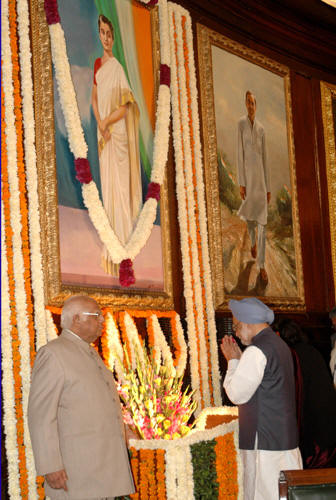 I remember that night…election night, watching on TV students rejoicing in the streets outside of Howard University (a local Historically Black University). I’m not sure how much of it was about Obama’s policy, or just the “historic” nature of the event, but it was all summed up to me as an African-American student holding back his tears said to a reporter, “I’m just so happy to have one of our guys in power.” It was a common sentiment, but this statement stuck in my head for several days. What did he mean by this? What was his expectation of President Obama over the next 4 years? Did he think just because a black man is in office, all of a sudden the American experience will now change for black people? That the wrongs of their history will now become right? That discriminatory laws and policies toward black people will all of a sudden be overturned? If that is what he meant, then I understand the celebration…but I would celebrate with caution.
I remember that night…election night, watching on TV students rejoicing in the streets outside of Howard University (a local Historically Black University). I’m not sure how much of it was about Obama’s policy, or just the “historic” nature of the event, but it was all summed up to me as an African-American student holding back his tears said to a reporter, “I’m just so happy to have one of our guys in power.” It was a common sentiment, but this statement stuck in my head for several days. What did he mean by this? What was his expectation of President Obama over the next 4 years? Did he think just because a black man is in office, all of a sudden the American experience will now change for black people? That the wrongs of their history will now become right? That discriminatory laws and policies toward black people will all of a sudden be overturned? If that is what he meant, then I understand the celebration…but I would celebrate with caution.
Five years ago, many Sikhs were celebrating in the streets as well. Finally, one of “our guys” had become Prime Minister. Manmohan Singh was elected selected as the 17th Prime Minister of India, by Sonia Gandhi herself. Sikhs all over the world rejoiced. Even many of the Sikh political prisoners in jail were celebrating with this victory, believing their release was now imminent.
Even some of my more progressive and panthic-minded friends got caught up in “Manmohan Singh Fever” and encouraged me to give him the benefit of the doubt. After all, how could we judge him? Who knows what he may do for us?
I, however, remained skeptical.
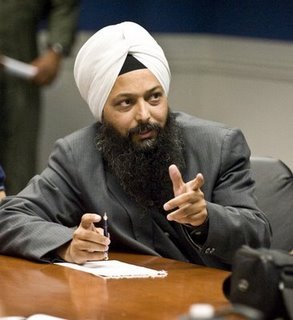 Last week, we saw the birth of a new Sikh folk hero. I am sure the dhadhi jathas (just as Chuck D called rap music the CNN of black people, dhadhi jatha is the CNN of the Sikhs) are already warming up their sarangi and dhad.
Last week, we saw the birth of a new Sikh folk hero. I am sure the dhadhi jathas (just as Chuck D called rap music the CNN of black people, dhadhi jatha is the CNN of the Sikhs) are already warming up their sarangi and dhad.
While other commenters have suggested material reasons for the turnabout in the Congress Party’s decision, I still contend that we must celebrate the Sikh masses for galvanizing the issue. The show of force came through Sikhs and their ‘rail roko’ with the shutting down of the railroad system throughout Punjab.
Although I am well aware of the political advantages that the Akali Dal and BJP sought to gain from the issue of the Delhi Pogroms of 1984, I hope for naysayers, worst of all those within our community, that like to state “the past is the past” and “let bygones be bygones” they realize the past does affect the present and life still does reside within the Sikh masses and polity.
Our so-called “leaders” rarely lead. Throughout Sikh history, it has been the masses that have had to goad these so-called leaders. Whether it was the movement to free the Gurdwaras from British-Mahant control during the early part of the 20th century or even the Sarbat Khalsa and subsequent declarations at the Akal Takht in 1986, the Sikh masses have always been the main impetus of the Qaum. The Guru Granth Sahib is our guide and the Guru Khalsa Panth (and not individual leaders, be they SAD Presidents or Jathedars) is our temporal collective body.
As we remember 1984 through concerts and acts of rebellion, let’s not forget the visceral spirit displayed by Singhs IN that time period.
Watch below the original version of a Punjabi kavita sung by Bhai Gursharan Singh during those turbulent times in Manji Sahib Hall located in the Darbar Sahib complex . This kavita captures the mood and spirit of those days. Tigerstyle later used it in one of their Shaheedi CDs to REMEMBER that spirit.
Intellectually, we can try to REMEMBER those days; but this kavita actually makes us FEEL how it was to live through that time.

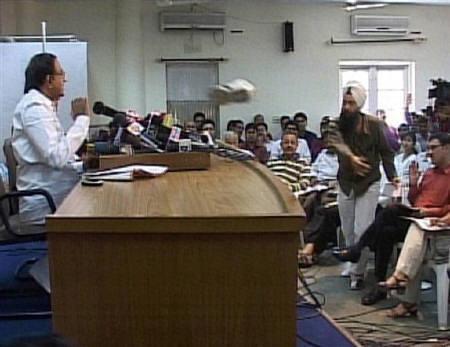 I know many will object to this post and ask how does a shoe bring justice to the thousands that lost their lives in 1984? My reply – it doesn’t.
I know many will object to this post and ask how does a shoe bring justice to the thousands that lost their lives in 1984? My reply – it doesn’t.
But what it does do is highlight the farce that calls itself Indian justice.
Earlier this week, I wrote about Sikh outrage against the Congress Party’s continuance of giving electoral posts to genocidal murders. While I still hold my claim of an independent position against Parkash Badal, the Akali Dal, and the BJP’s opportunism and the Congress Party’s celebration of impunity, the action of journalist Jarnail Singh warrants commentary and analysis.
Well, it seems like the sex ratio in Punjab is not improving despite the number of trees Mrs. Badal is planting and the SGPC’s desire to raise unwanted girl children.
The Tribune reports:
In 2001, the census of India recorded Punjab’s sex ratio at 876 females for 1,000 males, one of the worst in the country. The preliminary findings of a Lucknow-based agency AMS engaged by the government to assess the current situation shows that sex-ratio in many districts of the state has plummeted further.
First, AMS’s study has called out the Punjab government’s bluff in data collection. Apparently, the data collected by Punjab government agencies painted “… an unbelievably rosy picture of the situation”. The Social Security Department and Health Department have reported two different results. These results also do not match those of AMS.
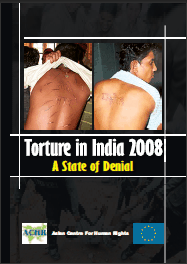 I recently stumbled on a report from the Asian Centre for Human Rights (ACHC), titled Torture in India 2008: A State of Denial. This document claims to be “the first nationwide assessment of the use of torture in India.”
I recently stumbled on a report from the Asian Centre for Human Rights (ACHC), titled Torture in India 2008: A State of Denial. This document claims to be “the first nationwide assessment of the use of torture in India.”
ACHC is a Delhi-based organization focused on protecting human rights throughout Asia, with what appears to be a specific focus on South Asia. I’m not familiar with this organization, so I’d be curious to hear if others can support or disprove their work.
The report focuses on the use of torture by police and security forces from routine arrests to counter-insurgency operations. Although it is clearly a preliminary analysis, it’s findings are quite alarming. The report notes:
The statistics of NHRC imply that in the last five years 7,468 persons at an average of 1,494 persons per year or four persons in a day died in police and prison custody in India. However, these figures represent only a fraction of the actual cases of torture. Cases of torture not resulting in death are not recorded.
Particularly troublesome was the section on custodial torture of women and children.
 As previously discussed, 1984 continues to haunt the psyche of a new generation of Sikhs. As justice continues to be denied to those that faced the Sikhs’ Kristallnacht in Delhi, the perpetrators of the heinous pogroms continue to roam the streets with impunity and some even continue to be awarded ministerial and cabinet positions by the government.
As previously discussed, 1984 continues to haunt the psyche of a new generation of Sikhs. As justice continues to be denied to those that faced the Sikhs’ Kristallnacht in Delhi, the perpetrators of the heinous pogroms continue to roam the streets with impunity and some even continue to be awarded ministerial and cabinet positions by the government.
With the upcoming elections in India, Jagdish Tytler has been nominated by the Congress Party to run for the Lok Sabha Member of Parliament (MP) in northeast Delhi.
The Jathedar of the Akal Takht, Gurbachan Singh, and SGPC officials have called for a protest outside the residence of Congress Party president, Sonia Gandhi.
No Sikh should think that the call could have been given by the Jathedar without the expressed permission of Parkash Badal and that too for electoral gain. Kaka Badal, Sukhbir Badal, has already used the issue to call for Congress Party head, Captain Amrinder Singh (scion of the house of Patiala) to resign from his position.
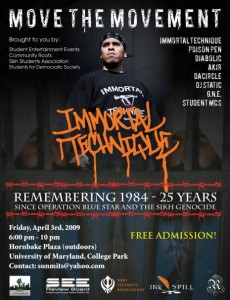 I know this concert has already been discussed, but the event had been postponed to this coming Friday…and with all the local buzz…it got me thinking about how we remember 1984.
I know this concert has already been discussed, but the event had been postponed to this coming Friday…and with all the local buzz…it got me thinking about how we remember 1984.
The Sikh Student Association here at the University of Maryland, in conjunction with other student groups, is sponsoring a free concert on April 3rd, 2009 to mark the 25th anniversary of the 1984 Sikh genocide. In a previous post Truth To Power – in reference to the recent Ensaaf report, I had stated:
We must read such reports and present them … anywhere and everywhere … to anyone who will listen: our gurdwaras, our local Amnesty International chapters, student groups, talk radio, public television, newspaper op-eds, etc. We must also create awareness of these findings in whatever format we can – through music, art, theatre and poetry.
The featured performer for the concert is Immortal Technique, an up-and-coming rapper who attracts a large and diverse audience, especially amongst college students. His intense style, controversial lyrics, and willingness to approach political subjects, such as the mid-east conflict, have made him a fan favorite amongst the politically aware.
It is refreshing to see students think “out-of-the-box” in remembering 1984, by attracting a mainstream artist and joining forces with other student activist groups under the tagline “Move the Movement.” The SSA plans to distribute background material on the 1984 atrocities and subsequent human rights violations, as well as feature short video clips and interviews with victims in between acts.
Radio Free Afghanistan 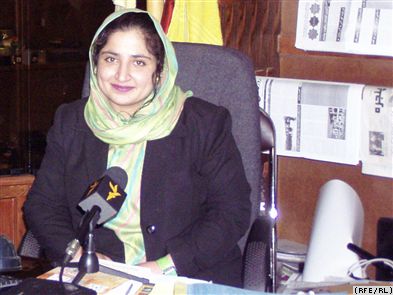 just chose Anarkali Honaryar for their “Person of the Year” award. Coincidentally, Anarkali is a member of Afghanistan’s minority Sikh community. At 25 years old, Anarkali is also a physician, a human rights activist, a member of Afghanistan’s Constitution Committee, and works for the Independent Human Rights Commission of Afghanistan. Oh, and she finished high school at 12.
just chose Anarkali Honaryar for their “Person of the Year” award. Coincidentally, Anarkali is a member of Afghanistan’s minority Sikh community. At 25 years old, Anarkali is also a physician, a human rights activist, a member of Afghanistan’s Constitution Committee, and works for the Independent Human Rights Commission of Afghanistan. Oh, and she finished high school at 12.
Wow. I think another fitting title would be Sikh Role Model of the Year (or the decade?). She has definitely just become my role model. And we can definitely add her to our list of sheroes.
Just what exactly was Anarkali given this award for?
She is well-known for helping women who suffer from domestic abuse, forced marriages, and gender discrimination. Honaryar is also an advocate on behalf of Afghanistan’s small, embattled Hindu minority, which lives in squalid conditions and faces harassment and discrimination. “We are thrilled to recognize Anarkali for her tireless work in promoting democracy, human rights, and civil society in Afghanistan,” said Radio Free Afghanistan Director Akbar Ayazi. “Anarkali has been taking part in Afghanistan’s reconstruction since she was a teenager — this recognition is well-deserved.” [Radio Free Europe]
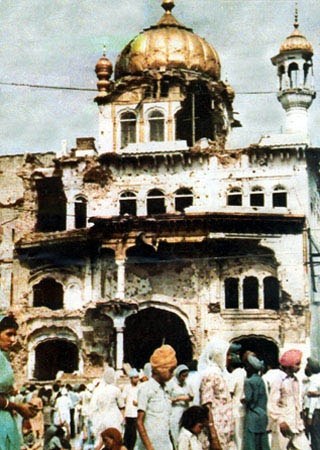 In time for the beginning of the Sikh New Year according to our own Nanakshahi calendar, the Shiromani Gurdwara Parbhandak Committee (SGPC) has released its annual calendar. In this 25th year of remembering the events of 1984, it is a moment for Sikhs to reflect and take lesson as well as maybe something for India to reflect and takes lesson as well (hopefully not the so-called morally-bankrupt, heinous ‘Punjab lesson.’)
In time for the beginning of the Sikh New Year according to our own Nanakshahi calendar, the Shiromani Gurdwara Parbhandak Committee (SGPC) has released its annual calendar. In this 25th year of remembering the events of 1984, it is a moment for Sikhs to reflect and take lesson as well as maybe something for India to reflect and takes lesson as well (hopefully not the so-called morally-bankrupt, heinous ‘Punjab lesson.’)
This year’s calendar includes a picture of the Akal Takht, bullet-ridden and tank-bombed, after the Battle of Amritsar. The call for SGPC recognition has been long overdue. Activists within the Sikh community have been calling for official recognition of the Third Sikh Genocide (Third Ghallughara) for years. Finally the SGPC has taken action.
Unfortunately, the SGPC does not act at the behest of the community, but only at the behest of Badal. In an election year, many are seeing the picture’s inclusion as an attempt by the Akali Dal (Badal) to play upon Sikh public sentiments against the Congress Party in Punjab.
 Although it has been a few months since its ‘soft opening’, the National Sikh Heritage Centre and Holocaust Museum at Derby in the UK in July will soon host the Queen of England, Elizabeth II, to inaugurate the museum.
Although it has been a few months since its ‘soft opening’, the National Sikh Heritage Centre and Holocaust Museum at Derby in the UK in July will soon host the Queen of England, Elizabeth II, to inaugurate the museum.
Although many Gurdwaras have a ‘museum’-room and apparently on the internet we have a cybersikhmuseum, the initiative to bring scattered items of Sikh heritage is much needed and should be lauded.
The Museum hosts a number of artifacts, including a canon that belonged to the Sarkar-e Khalsa during the time of Sardar (often erroneously called Maharaja by Sikhs) Ranjit Singh.
The library is currently featuring an exhibit ‘From Jawans to Generals’ and in May will begin an exhibit on the Sikh Holocaust of 1984. They are beginning to collect rare books and hoping that the library will become a hub for Sikh scholarship.
The museum by bringing many such historical artifacts, located throughout UK together is more proof of the burgeoning of the Diaspora Sikh community and its finding new ways to engage with its changing self as well as non-Sikh community members. One hopes we will see similar initiatives in the US and Canada as well.
If Baldev Mutta’s cellphone rings in the middle of a meeting, he picks it up. If it beeps over dinnertime or at midnight, he answers it. And if he has to go out to pick up a woman and find her a spot at a shelter at 3 a.m., he will do it. “It can mean the difference between life and death for a woman,” said Mutta, executive director of Punjabi Community Health Services in Brampton. “They are abused and don’t have anywhere else to go. This agency is their lifeline.” [link]
The Punjabi Community Health Services is an organization based in Brampton, Canada which provides various services to Punjabi women who have been abused. Instead of waiting for women to turn up at their doorstep, this organization takes a proactive approach by sending workers into the community to speak with abused women. They visit Gurdwaras and community centers to find women in distress. At times they must speak with the women secretly at doctor’s appointments, grocery stores, even parking lots, so their families don’t find out.
::
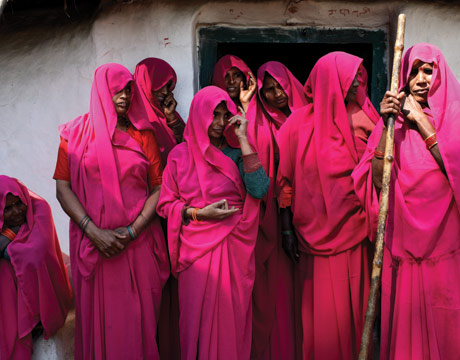 In related news, I recently read an article about the “Gulabi Gang” in an issue of Marie Claire which appeared on New America Media yesterday aswell. The Gulabi Gang are a group of women in India who have come together to fight against abuse. When local officials refused to take action against an alleged rapist, scores of pink-sari-clad women stormed the police station, demanding action – and thus, became know as the Gulabi Gang. For example, when Sampat Pal Devi learned that a friend had been beaten by her alcoholic husband and that the local police, chronically indifferent to violence against women, had looked the other way, something inside her snapped. In an effort to fight back, she gathered dozens of her female neighbors, armed them with sticks, and taught them how to fight back. Together, the self-declared Gulabi Gang have beaten up accused rapists, profligate officials, and husbands who’ve abandoned their wives.
In related news, I recently read an article about the “Gulabi Gang” in an issue of Marie Claire which appeared on New America Media yesterday aswell. The Gulabi Gang are a group of women in India who have come together to fight against abuse. When local officials refused to take action against an alleged rapist, scores of pink-sari-clad women stormed the police station, demanding action – and thus, became know as the Gulabi Gang. For example, when Sampat Pal Devi learned that a friend had been beaten by her alcoholic husband and that the local police, chronically indifferent to violence against women, had looked the other way, something inside her snapped. In an effort to fight back, she gathered dozens of her female neighbors, armed them with sticks, and taught them how to fight back. Together, the self-declared Gulabi Gang have beaten up accused rapists, profligate officials, and husbands who’ve abandoned their wives.
 Last week, the International Criminal Court (ICC), issued an arrest warrant for current President of Sudan, Omer Hassan Al-Bashir. Al-Bashir has been charged with five counts of crimes against humanity: murder, extermination, forcible transfer, torture and rape. He also faces two counts of war crimes. The ICC may be growing its first tooth.
Last week, the International Criminal Court (ICC), issued an arrest warrant for current President of Sudan, Omer Hassan Al-Bashir. Al-Bashir has been charged with five counts of crimes against humanity: murder, extermination, forcible transfer, torture and rape. He also faces two counts of war crimes. The ICC may be growing its first tooth.
Behind the warrant were the many groups that have tirelessly worked to bring global attention to the matter. The ‘Save Darfur’ campaign has been extremely successful example in rallying public support, beginning in churches and university campuses, to influence the public dialogue and bring pressure upon public officials. Through organizing local events, but aiming to influence public opinion on a global level, the campaign is a model in their use of new media, internet, and public rallies and theatre to bring attention to the genocide and plight of a people. While I am in admiration of the campaigns strategies and efforts, it is still worthwhile to ponder on global culpability in allowing such genocides to continue to occur.
As part of these efforts, the campaign has been successful in bringing pressure upon China for its continued support of the genocidal regime and its willingness to condone the Sudanese government’s behavior in its bid to keep receiving returns on its billions of dollars investment into the country’s oil industry. Although on some level I understand realpolitik and China’s strategy of attempting to find oil supplies in those states that are considered pariahs by the US in order for China to satiate its growing oil needs. Still I cannot condone such actions and cannot trade human life for oil.
Grassroots efforts and political efforts are starting to show that the pressure upon China for its support of Sudan is beginning to have effect. Steven Spielberg’s boycott of the Beijing Olympics was one example. Protecting Sudan through its veto ability in the Security Council of the United Nations (UN), it is understandable why world pressure focuses on China. It is heartening that the pressure may even be beginning to have some effect.
However, left out of the equation is India.
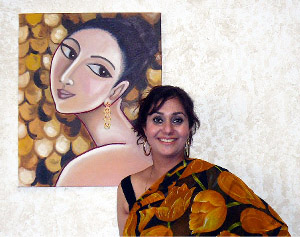 As International Women’s Day approaches us this weekend, I wanted to highlight the story of one woman who left a life of violence to a home of comfort built from creativity. Tanya Momi, a Bay Area South Asian woman from Chandigarh, is a painter and owner of “Spoil-Me Salon”, who left a long-term abusive marriage where she was treated like an “educated maid”. On March 8th her work will be launched in San Francisco as part of Amnesty International’s Stop Violence Against Women’s traveling art exhibit.
As International Women’s Day approaches us this weekend, I wanted to highlight the story of one woman who left a life of violence to a home of comfort built from creativity. Tanya Momi, a Bay Area South Asian woman from Chandigarh, is a painter and owner of “Spoil-Me Salon”, who left a long-term abusive marriage where she was treated like an “educated maid”. On March 8th her work will be launched in San Francisco as part of Amnesty International’s Stop Violence Against Women’s traveling art exhibit.
Vidya Pradhan writes:
“Tanya Momi rebuilt her life after a traumatic marriage and divorce and in her own quiet way she helps other women do the same. “Women come into my life through the salon,” she says. “They are like the missing puzzle pieces of my life.” Through her work in the salon and her paintings she reaches out to offer comforting messages of hope and renewal.”
 Not in India! In India, the state only engages in what is euphemistically called “fake encounters.” While many in the Sikh community remember the tragic events of 1984, in many ways the events did not just transform the Sikh nation, but has had a lasting effect on the Indian state.
Not in India! In India, the state only engages in what is euphemistically called “fake encounters.” While many in the Sikh community remember the tragic events of 1984, in many ways the events did not just transform the Sikh nation, but has had a lasting effect on the Indian state.
Rarely do I see this line of questioning amongst Indian academics, elite, or the media. Violence does not only affect the victim, but the perpetrator is also transformed. Last week, I commented on one such transformation in the Indian State – when a mainstream journalist can openly call for “state terror(ism)” as a tactic to perpetrate against its own citizenry.
This week, in a related story, but still somewhat different, I highlight the euphemism “fake encounter”. Although this term had traction before 1984 and was one of the spearheads against which Baba Jarnail Singh Bhindranwale fought against, it was in the post-1984 Punjab that supposed “encounter deaths” became so widespread and with a complacent Indian press parroting the State’s reports soon found them relegated to back pages. If there truly is a “Punjab lesson”, it was that other Indian State agencies could engage in these “fake encounters” with complete impunity. The latest case comes from the state of Chhatisgarh and the rural areas near Singaram.
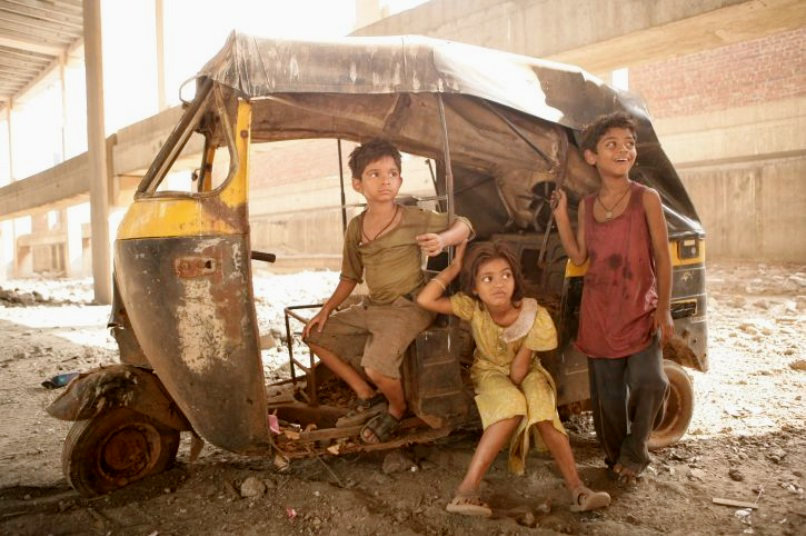 Amidst all the “Slumdog Millionaire” Oscar hysteria, some have been asking how are we ACTUALLY going to combat the issues of poverty in Indian slums? I heard on “Entertainment Tonight”, or some show like that, the movie’s directors/producers have set up a trust-fund for the child-stars (who currently live in slums), are paying for their families to move into decent apartments, and will be paying for the children’s education.
Amidst all the “Slumdog Millionaire” Oscar hysteria, some have been asking how are we ACTUALLY going to combat the issues of poverty in Indian slums? I heard on “Entertainment Tonight”, or some show like that, the movie’s directors/producers have set up a trust-fund for the child-stars (who currently live in slums), are paying for their families to move into decent apartments, and will be paying for the children’s education.
But how about the rest of the families who were cheering away in Mumbai slums as “Slumdog Millionaire” won its eight Oscars? I came across this great blog post by Minal Hajratwala, “Slumdog”: Don’t Just Watch, Do Something, which took scenes from the movie and talked about how we can address those poverty issues in reality. I am going to copy a few of those segments here, but please do visit Minal’s blog for the full-effect.
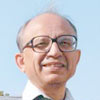 I have blogged about this issue before and since I find it so irritating, expect me to highlight them over and over. The most recent re-incarnation of the ‘abuse’ of the ‘Punjab Lesson’ comes from the always problematic Times of India. Swaminathan Aiyar, a libertarian columnist, in his “Swaminomics” has just written “Pakistan needs a Beant Singh”.
I have blogged about this issue before and since I find it so irritating, expect me to highlight them over and over. The most recent re-incarnation of the ‘abuse’ of the ‘Punjab Lesson’ comes from the always problematic Times of India. Swaminathan Aiyar, a libertarian columnist, in his “Swaminomics” has just written “Pakistan needs a Beant Singh”.
Decrying the truce reached by the Pakistani government and tribal forces in the Swat Valley, Aiyar sees parallels with India in the 1980s and specifically Punjab:
The Taliban’s rise in Pakistan has something in common with Bhindranwale’s rise in Punjab. A religious preacher, he sought to purge Sikhism of modern evils and return to pristine Sikhism. He was outraged by reformist Sikhs like the Nirankaris, and his followers killed many Nirankaris including the Nirankari Baba. [Emphasis added][link]
Nirkankaris were reformists? Claiming a living Guru that was greater than the Guru Granth Sahib and opening fire on protesting Sikhs in 1978 is reform? But I digress….
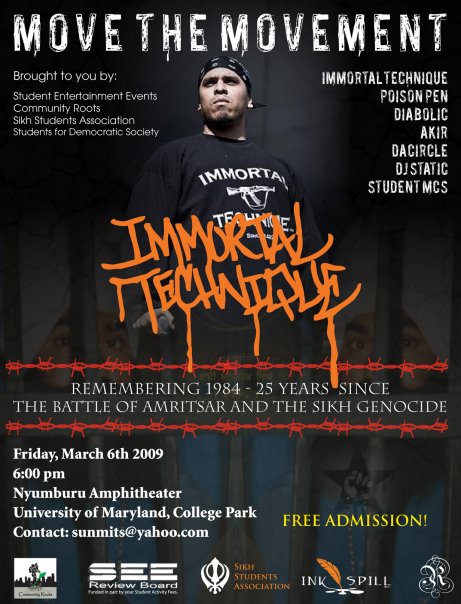 2009 marks the 25th year since the events of 1984. Tragedy and the vibrancy of life mark the ‘story’ that is 1984 and beyond. There will be many activities I assume over the next few months and I will do my best to stay informed and encourage participation by our readers, writers, and beyond.
2009 marks the 25th year since the events of 1984. Tragedy and the vibrancy of life mark the ‘story’ that is 1984 and beyond. There will be many activities I assume over the next few months and I will do my best to stay informed and encourage participation by our readers, writers, and beyond.
Last year, I wrote that I was a HUGE fan of Immortal Technique. Although some of the commenters could not move beyond his usage of profanity, I think they are losing out on a phenomenal activist and inspiration. In that post I had mentioned his usage of a Sikh analogy, it seems next month he may be doing much more. The Sikh Students Association at the University of Maryland, College Park is one of the groups playing host to an upcoming performance on March 6th, 2009 at 6pm. The tagline of one of the posters (well one that I am sure the Sikh groups are promoting) is “Remembering 1984: 25 Years Since the Battle of Amritsar and the Sikh Genocide“. For more information visit Tech’s myspace page that states that free admission will be limited to the first 500 people.
Another great initiative that was recently brought to my attention is the “One Million Chaupai Sahibs” project. The target: 1,000,000 Chaupai Sahibs by June 2009. Whether individually or collectively, I hope the TLH community actively supports the project.
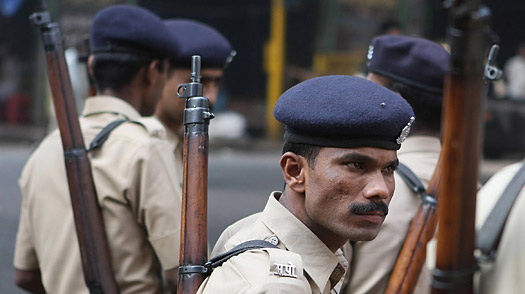
We recently posted on Ensaaf’s new report that studies the all too common practice of extra-judicial killings (usually referred to as ‘encounters’) and the mass cremations that followed by the Punjab police forces during the 1980s and 1990s. Well it looks like these practices were not limited to Punjab and these serious human rights violations are finally hitting the mainstream media.
This week, Time magazine writes about “Rights Groups Probe India’s Shoot-Out Cops“:
Scarcely a day passes in India by without news of an encounter between the police and criminals elements — “encounter” being the local jargon for shootouts involving the police, who are allowed to fire only in self-defense. On Wednesday, it was a “dreaded mafia don” who was gunned down by the Uttar Pradesh police — shot dead, and therefore unable to challenge the police account of the circumstances of the shooting. But some in India have begun to question the frequency of such “encounters”.
